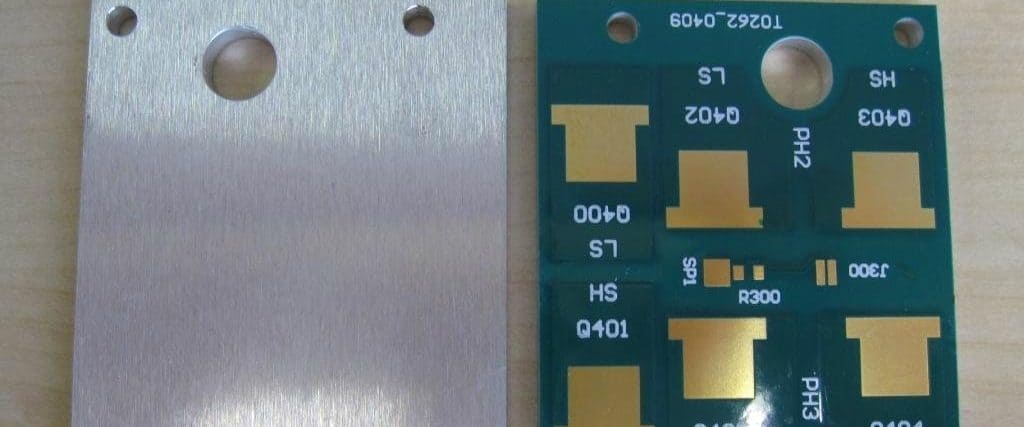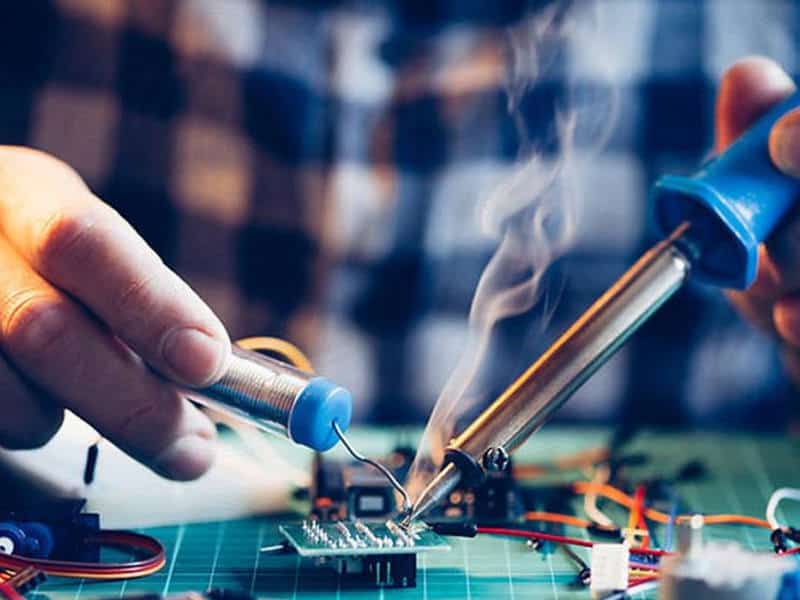Soldering irons are essential tools for electronics hobbyists and professionals alike. They are used to connect components on printed circuit boards (PCBs) by melting a small amount of metal alloy, called solder, onto the connections. A good soldering iron can make all the difference in the quality of the final product, as well as the ease and speed of the soldering process.
When choosing a soldering iron for PCB work, there are several factors to consider. The wattage of the iron, the temperature control, the tip shape and size, and the ergonomics of the handle are all important considerations. Additionally, the type of soldering iron you choose will depend on the size and complexity of the PCBs you will be working on, as well as your level of experience and comfort with soldering. With the right soldering iron, you can achieve clean, reliable connections on your PCBs and take your electronics projects to the next level.
What is a Soldering Iron?
A soldering iron is a tool that is used to melt and join two metal surfaces together using a filler metal called solder. It is a common tool used in electronics and metalworking for making electrical connections and repairs.
Types of Soldering Irons
There are several types of soldering irons available, each with its own unique features and benefits. Here are some of the most common types:
-
Standard Soldering Iron: This is the most basic type of soldering iron and is suitable for most general soldering tasks. It typically has a power rating of 15-30 watts and can be used for soldering small components and wires.
-
Temperature Controlled Soldering Iron: This type of soldering iron allows you to adjust the temperature of the tip, making it suitable for more delicate soldering tasks. It is ideal for working with sensitive electronic components that require precise temperature control.
-
Butane Soldering Iron: This type of soldering iron is powered by butane gas and is ideal for use in areas where there is no electricity supply. It is also portable and can be used for outdoor soldering tasks.
-
Cordless Soldering Iron: This type of soldering iron is battery-powered and does not require a power outlet. It is ideal for use in areas where there is no electricity supply or when you need to work in tight spaces.
-
Soldering Station: This is a complete soldering system that includes a temperature-controlled soldering iron, a stand, and other accessories. It is ideal for professional use and can be used for a wide range of soldering tasks.
In conclusion, soldering irons are essential tools for anyone who works with electronics or metalworking. Choosing the right type of soldering iron depends on the type of work you will be doing, your skill level, and your budget.
Why Use a Soldering Iron for Printed Circuit Boards?
Soldering is a process of joining two or more metals by using a filler metal called solder. A soldering iron is a tool used to heat the solder and melt it onto the metal surface to create a strong and permanent bond. In the world of electronics, a soldering iron is an essential tool for assembling and repairing printed circuit boards (PCBs).
Here are some reasons why a soldering iron is important for working with PCBs:
-
Precision: A soldering iron allows you to make precise and accurate connections between components on a PCB. The tip of a soldering iron can be shaped to fit the specific size and shape of the component, making it easier to work with small and delicate parts.
-
Durability: Soldered connections are more durable and reliable than other methods of joining components. The solder creates a strong bond between the metal surfaces, which is resistant to vibration, heat, and other environmental factors.
-
Flexibility: Soldering allows you to connect components in a variety of ways, including surface mount, through-hole, and wire-to-board connections. This flexibility makes it possible to design and build complex circuits with a range of components.
-
Cost-effective: Soldering is a cost-effective way to assemble and repair PCBs. The equipment and materials required for soldering are relatively inexpensive, and the process is quick and efficient.
In summary, a soldering iron is an essential tool for anyone working with printed circuit boards. It allows for precise, durable, and flexible connections between components, and is a cost-effective way to assemble and repair PCBs.

Factors to Consider When Choosing a Soldering Iron for Printed Circuit Boards
When it comes to soldering printed circuit boards (PCBs), having the right soldering iron is crucial. Here are some factors to consider when choosing a soldering iron for PCBs:
Temperature Control
Temperature control is essential when soldering PCBs. The temperature needs to be precise and consistent to avoid damaging the board or components. Look for a soldering iron with adjustable temperature control and a digital display to ensure accuracy.
Tip Size and Shape
The size and shape of the soldering iron tip are important factors to consider. A smaller tip allows for precision when working with small components, while a larger tip is better suited for larger components. Additionally, the shape of the tip affects how the solder flows and can impact the quality of the joint. Consider the type of components you will be working with and choose a tip size and shape accordingly.
Power and Wattage
The power and wattage of the soldering iron determine how quickly it heats up and how well it maintains temperature. A higher wattage soldering iron will heat up faster and maintain temperature better, but may be too powerful for delicate work. Consider the size and complexity of the PCBs you will be working with and choose a soldering iron with an appropriate wattage.
Corded vs. Cordless
Corded soldering irons provide a consistent source of power and are typically more powerful than cordless models. However, cordless soldering irons offer greater portability and flexibility. Consider your workspace and the nature of your work when choosing between corded and cordless.
Additional Features
Some soldering irons come with additional features, such as a built-in stand or a temperature lock. These features can make the soldering process easier and more efficient. Consider which features are important to you and choose a soldering iron that meets your needs.
In conclusion, choosing the right soldering iron for PCBs is essential for achieving quality results. Consider factors such as temperature control, tip size and shape, power and wattage, corded vs. cordless, and additional features to make an informed decision.
How to Use a Soldering Iron for Printed Circuit Boards
Preparing the Circuit Board
Before starting to solder, make sure that the circuit board is clean and free from any debris or dust. It is recommended to use a cleaning solution to clean the board, and then let it dry completely before proceeding.
Preparing the Soldering Iron
Make sure that your soldering iron is clean and in good condition. If there is any rust or corrosion on the tip, use sandpaper to clean it. Also, make sure that the tip is tinned before starting to solder. This means applying a small amount of solder to the tip so that it is coated with a thin layer of solder.
Applying Solder to the Circuit Board
To apply solder to the circuit board, hold the soldering iron in one hand and the solder wire in the other hand. Place the tip of the soldering iron on the pad that you want to solder and hold it there for a few seconds. Then, touch the solder wire to the pad and let it melt. Move the solder wire along the pad until you have applied enough solder.
Finishing the Soldering Process
After applying the solder, remove the soldering iron from the pad and let the solder cool down. Make sure that the solder joint is smooth and shiny. If there are any rough spots or bumps, use a solder wick to remove the excess solder. Finally, inspect the solder joint to make sure that it is strong and secure.
In conclusion, using a soldering iron for printed circuit boards requires careful preparation and attention to detail. By following the steps outlined above, you can ensure that your solder joints are strong and secure.

Tips for Maintaining Your Soldering Iron
To ensure the longevity and effectiveness of your soldering iron, it is important to maintain it properly. Here are some tips for maintaining your soldering iron:
Clean the Tip Regularly
The tip of your soldering iron is the most important part of the tool. It is essential to keep it clean to ensure proper heat transfer and to avoid oxidation. You can clean the tip of your soldering iron using a damp sponge or a brass wire cleaner. Always clean the tip when the iron is hot and turn off the iron when you are done.
Use the Right Temperature
Using the right temperature is essential for proper soldering. If the temperature is too high, it can damage the components, and if it is too low, it can result in poor solder joints. Always refer to the manufacturer’s instructions to determine the right temperature for your soldering iron.
Replace the Tip When Necessary
Over time, the tip of your soldering iron can become worn out or damaged. It is essential to replace the tip when necessary to ensure proper heat transfer and to avoid oxidation. Always use the right tip for the job and make sure it is compatible with your soldering iron.
Store the Soldering Iron Properly
When you are not using your soldering iron, it is important to store it properly. Always turn off the iron and unplug it from the power source. Store the iron in a dry and cool place, away from direct sunlight and moisture.
Use the Right Solder
Using the right solder is essential for proper soldering. Always use high-quality solder that is compatible with your components and your soldering iron. Avoid using low-quality solder, as it can result in poor solder joints and damage your components.
By following these tips, you can ensure the longevity and effectiveness of your soldering iron.
Conclusion
In conclusion, a soldering iron is an essential tool for anyone working with printed circuit boards. It allows for precise and accurate soldering of components onto the board, ensuring a strong and reliable connection.

When selecting a soldering iron, it is important to consider the wattage, temperature control, and tip size. A higher wattage iron will heat up faster and maintain a consistent temperature, while a smaller tip size allows for more precision in tight spaces.
It is also important to use the correct solder and flux for the job to ensure a strong and reliable connection. Lead-free solder is becoming more popular due to environmental concerns, but it requires a higher temperature and may not be compatible with older equipment.
Overall, investing in a quality soldering iron and taking the time to learn proper soldering techniques can greatly improve the quality and reliability of your printed circuit board projects.
Comments are closed